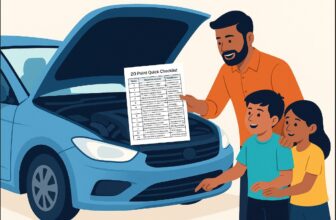Highway driving in India can be a challenging experience, with fast-moving traffic, varying road conditions, and frequent obstacles. Accidents on highways are a significant concern, and while infrastructure improvements are underway, the responsibility for safety largely lies with the drivers. This article highlights essential practices to ensure safety and minimize accidents while driving on highways in India.
Highway Driving Safety Tips for India: 12 Key Practices to Prevent Accidents:
1. Essential Pre-Trip Vehicle Checks for a Safe Highway Journey
Before embarking on a long-distance journey, adequate preparation is crucial to ensure safety.
- Vehicle Inspection: Check the condition of your vehicle, including brakes, tires, headlights, and windshield wipers. Ensure the oil levels, coolant levels, and tire pressure are optimal.
- Emergency Kit: Carry an emergency kit that includes a first aid box, a flashlight, a basic toolkit, and reflective warning triangles. This can help in case of unforeseen situations like breakdowns.
- Route Planning: Research the route beforehand to be aware of potential hazards, tolls, rest stops, and alternative routes in case of roadblocks. Apps like Google Maps and Waze provide real-time traffic updates, helping drivers avoid congested roads.
2. Speeding Isn’t Worth It: The Importance of Adhering to Speed Limits
India’s highways have designated speed limits, which are crucial for safe driving. Exceeding speed limits or driving too slowly can increase the likelihood of accidents.
- Follow Speed Limits: Always adhere to the posted speed limit. While highway roads in India are wide, speeding can lead to fatal accidents due to sudden obstacles, varying road conditions, or other drivers’ actions.
- Adjust Speed According to Conditions: Weather conditions such as fog, rain, or night driving reduce visibility and increase braking distances. Slow down in such conditions to maintain control of your vehicle.
3. Master Lane Discipline: A Key to Smooth and Safe Highway Driving
Maintaining lane discipline is crucial for avoiding accidents on highways.
- Stay in Your Lane: Do not frequently switch lanes unless necessary. Sudden lane changes can confuse other drivers and increase the risk of collisions.
- Use Indicators: Always use your indicators when changing lanes or making turns. This ensures other drivers can anticipate your movement, reducing the risk of accidents.
- Avoid Overtaking from the Left: On most Indian highways, overtaking should be done from the right side, unless the road signs indicate otherwise. Overtaking from the left can cause confusion and lead to head-on collisions.
4. Drive Defensively: Anticipating Hazards to Avoid Accidents
A defensive driving mindset helps anticipate potential dangers and take preventive actions.
- Keep a Safe Distance: Maintain a safe following distance of at least 2-3 seconds behind the vehicle in front of you. This allows enough time to react to sudden halts or obstructions.
- Be Mindful of Blind Spots: Always check your blind spots before changing lanes or overtaking. Other vehicles, including two-wheelers and trucks, may be difficult to spot in your mirrors.
- Expect the Unexpected: Highway driving can be unpredictable, especially in India, where vehicles of all kinds share the same roads. Be ready for sudden lane changes, pedestrians crossing the highway, or animals on the road.
5. Stay Focused: How to Eliminate Distractions for Safer Driving
Distractions are one of the leading causes of accidents. Avoiding distractions ensures better focus on the road.
- Limit Mobile Phone Use: Avoid using your mobile phone for calls or texting while driving. If necessary, pull over safely to make calls or use hands-free options.
- Control In-Car Distractions: Set your GPS or music system before starting the journey to prevent distractions while driving.
6. Traffic Rules Matter: Navigating Highways with Caution and Care
Though traffic rules are crucial everywhere, they are particularly important on highways due to the high speeds and potential hazards.
- Observe Traffic Signs: Follow all traffic signs, such as speed limits, roadwork warnings, and no-entry signs. Ignoring these can lead to accidents or fines.
- Respect Overtaking Rules: Always ensure that the overtaking lane is clear before proceeding. Avoid overtaking when there is a solid line or when visibility is poor.
7. Night Driving: Tips for Safer Travel After Dark
Driving at night requires extra attention, as visibility is significantly reduced.
- Use Headlights Properly: Use low beam headlights when driving in the presence of other vehicles and high beam only when the road ahead is clear and unoccupied.
- Rest When Tired: Fatigue can impair your ability to judge distance and respond quickly. Stop at regular intervals to rest and refresh, especially if driving for long periods.
8. Tackling Road Hazards: Common Highway Obstacles and How to Avoid Them
Highways in India may present different hazards that require special attention.
- Animal Crossings: In rural areas, animals such as cows, dogs, or goats may suddenly appear on the road. Slow down and keep an eye on the road edges, especially at night.
- Road Potholes: Potholes are common on some highways, particularly after heavy rains. Drive cautiously, especially in poorly lit areas, and avoid swerving abruptly to prevent losing control of the vehicle.
- Construction Zones: Always follow the detour signs and slow down when passing construction zones. Workers may be on the road, and the road surface may be uneven.
9. Stay Sober and Well-Rested: The Crucial Role of Mental Clarity in Safe Driving
Driving under the influence of alcohol or drugs is illegal and highly dangerous. Similarly, driving while fatigued can lead to poor decision-making and slower reaction times.
- Avoid Alcohol and Drugs: Never drive under the influence of alcohol or drugs. The effects can impair judgment, slowing down reflexes and reducing awareness of road conditions.
- Take Regular Breaks: Fatigue can set in during long drives, especially on highways. Take a 15-minute break every two hours to stretch, hydrate, and rest to stay alert.
10. Emergency Readiness: What to Do When Things Go Wrong on the Highway
Despite all precautions, emergencies can still happen. Being prepared to handle them can make a significant difference.
- Know How to Handle a Tire Blowout: If a tire blows out, remain calm and steer the vehicle straight. Gradually reduce speed by easing off the accelerator, and only apply brakes once the vehicle is stabilized.
- Contacting Authorities: If involved in an accident or experiencing a breakdown, know how to contact emergency services. The Highway Police in India can be reached through various helpline numbers, which differ by region.
11. Keep Your Fuel Tank Full: Prevent Running Out of Fuel Mid-Trip
Running out of fuel in the middle of a long journey can lead to unnecessary delays and safety hazards.
- Plan Fuel Stops: Make sure your fuel tank is full before heading onto the highway, and plan fuel stops along the route. Avoid pushing the limits of your tank, especially on remote stretches.
12. Weather-Ready Driving: Adapting to India’s Varied Climate Conditions
India’s weather conditions can change drastically, affecting road visibility and grip. Adjusting your driving to the weather can make a significant difference.
- Driving in the Rain: During monsoon seasons, roads can become slippery and visibility can be poor. Use your headlights, maintain a lower speed, and ensure your tires have adequate tread depth for better grip.
- Driving in Fog or Smog: Foggy or polluted conditions can dramatically reduce visibility. Keep a safe distance, use fog lights, and avoid high beams, as they can reflect off the fog and worsen visibility.
Summary
Driving on highways in India requires a combination of caution, preparation, and awareness. By following these safety practices—ensuring proper vehicle maintenance, adhering to speed limits, maintaining lane discipline, staying alert to road hazards, and being ready for emergencies—you can significantly reduce the risk of accidents and ensure a safer journey for yourself and others on the road. Safe driving not only protects lives but also contributes to a more efficient and smoother highway system across the country.





